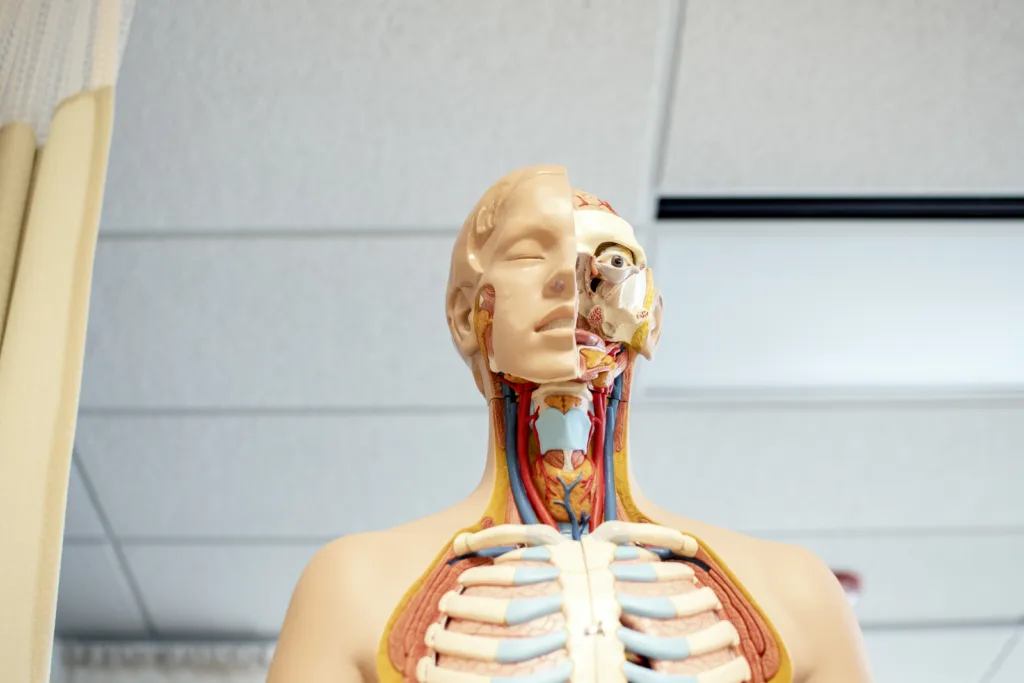The mylohyoid ridge (MR) is a bony ridge located on the lingual aspect of the mandible in the posterior region. This ridge is an important anatomic structure to consider during prosthetic treatment as it can affect the amount of available bone height in this area.
The mylohyoid muscle, which is responsible for elevating the hyoid bone and oral cavity, is attached to the mylohyoid ridge. This muscle is innervated by the mylohyoid nerve, which is a branch of the inferior alveolar nerve, a division of the trigeminal nerve.
The mandibular canal is also located in this region, which serves as a pathway for the inferior alveolar nerve and blood vessels. The nerve to mylohyoid, which supplies the mylohyoid muscle and anterior belly of digastric muscle, also runs in the mylohyoid groove of the mandible.
Dental professionals can use the mylohyoid ridge as a guide to determine the available bone height in the mandibular posterior region. Radiographic images can be used to locate the ridge and assess the amount of bone height available for implant placement.
In addition to its clinical importance, the mylohyoid ridge also has a role in forensic dentistry. The presence or absence of this ridge can be used to identify individuals based on teir dental records.
The mylohyoid ridge is an important anatomic structure to consider during prosthetic treatment and implant placement in the mandibular posterior region. Its location and relationship to the mandibular canal and nerve to mylohyoid make it a valuable guide for dental professionals.
What Is The Significance Of Mylohyoid Ridge?
The mylohyoid ridge (MR) is an important anatomic structure in the mandibular posterior region that can serve as a guide to determine the available bone height for prosthetic treatment. This ridge runs horizontally along the inner surface of the mandible, separating the alveolar ridge from the floor of the mouth. It is a crucial landmark for implant placement and is used to estimate bone height in the posterior mandible.
The significance of the MR lies in its ability to provide an indication of the amount of bone available for implant placement. This is espeially important in cases where there is limited bone height due to resorption or other factors. By using the MR as a guide, clinicians can accurately assess the available bone height and choose the appropriate implant size and placement location.
In addition to its use as a guide for implant placement, the MR also plays a role in the placement of removable dentures. It can be used as a guide for denture placement and can help to ensure proper retention and stability.
The mylohyoid ridge is an important anatomic structure that should be carefully considered in prosthetic treatment planning. Its significance lies in its ability to provide an indication of available bone height and to guide implant and denture placement.

What Is The Function Of Mylohyoid Groove?
The mylohyoid groove is a shallow groove or depression on the inner surface of the mandible, located superior to the mylohyoid line. The function of the mylohyoid groove is to provide a pathway for the mylohyoid nerve and vessels to travel from the mandibular foramen to the mylohyoid muscle, which is responsible for elevating the hyoid bone and the floor of the mouth durng swallowing and speaking. The mylohyoid groove is important because it protects the mylohyoid nerve and vessels from injury as they pass through the mandible. Additionally, the mylohyoid groove also serves as an attachment site for the mylohyoid muscle fibers, which originate from the mylohyoid line and the adjacent superior mental spine.
What Passes Through The Mylohyoid Groove?
The mylohyoid groove is a structure present on the inner surface of the mandible bone. It is a shallow depression that runs horizontally from the mandibular foramen to the mental foramen. The inferior alveolar nerve, whch is a branch of the mandibular division of the trigeminal nerve, passes through the mylohyoid groove. Additionally, the mylohyoid artery, which is a branch of the inferior alveolar artery, also runs in the mylohyoid groove. The nerve to mylohyoid, which is a branch of the inferior alveolar nerve, also travels through the mylohyoid groove to reach its target muscles in the submandibular region. Therefore, the mylohyoid groove serves as a pathway for important nerves and vessels that supply the lower teeth, chin, and muscles of the floor of the mouth.
Is The Mylohyoid Ridge The Same As The Internal Oblique Ridge?
The mylohyoid ridge and the internal oblique ridge are not the same. While both ridges are located on the mandible bone, the mylohyoid ridge is a bony prominence on the internal surface of the mandible that serves as the attachment site for the mylohyoid muscle. On the other hand, the internal oblique ridge is a bony ridge on the internal surface of the mandible that serves as the attachment site for the internal oblique muscle. These two structures have different functions and anatomical locations, and should not be confused with each other.
Conclusion
The mylohyoid ridge is a crucial anatomic structure that should not be overlooked during prosthetic treatment. It serves as a guide to determine the avaiable bone height in the mandibular posterior region and can assist in the placement of dental implants. The mylohyoid muscle has important functions in elevating the oral cavity and depressing the mandible, and it is innervated by the mylohyoid nerve, a branch of the inferior alveolar nerve. Additionally, the internal oblique ridge is sometimes referred to as the mylohyoid line, which adds to the complexity of this region. Radiographic imaging is necessary to identify the mandibular canal, which houses the inferior alveolar nerve and blood vessels. Understanding the anatomy and function of the mylohyoid ridge is essential for successful prosthetic treatment and implant placement in the mandibular posterior region.
